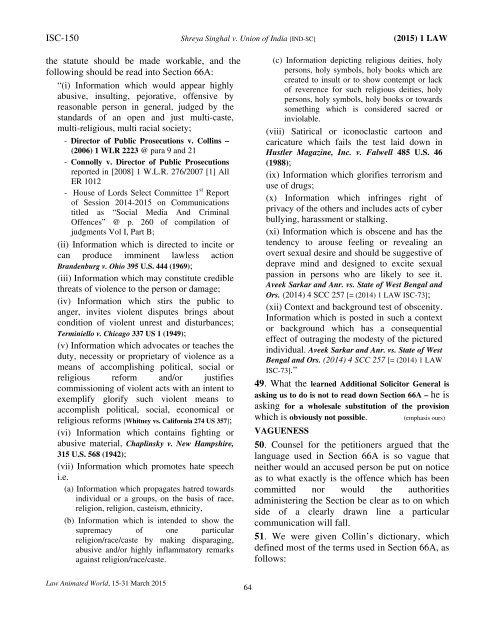Editor: I. Mallikarjuna Sharma Volume 11: 15-31 March 2015 No. 5-6
Martyrs memorial special issue of 15-31 March 2015 paying tributes to Bhagat Singh and other comrades.
Martyrs memorial special issue of 15-31 March 2015 paying tributes to Bhagat Singh and other comrades.
Create successful ePaper yourself
Turn your PDF publications into a flip-book with our unique Google optimized e-Paper software.
ISC-<strong>15</strong>0 Shreya Singhal v. Union of India [IND-SC] (20<strong>15</strong>) 1 LAW<br />
the statute should be made workable, and the<br />
following should be read into Section 66A:<br />
“(i) Information which would appear highly<br />
abusive, insulting, pejorative, offensive by<br />
reasonable person in general, judged by the<br />
standards of an open and just multi-caste,<br />
multi-religious, multi racial society;<br />
- Director of Public Prosecutions v. Collins –<br />
(2006) 1 WLR 2223 @ para 9 and 21<br />
- Connolly v. Director of Public Prosecutions<br />
reported in [2008] 1 W.L.R. 276/2007 [1] All<br />
ER 1012<br />
- House of Lords Select Committee 1 st Report<br />
of Session 2014-20<strong>15</strong> on Communications<br />
titled as “Social Media And Criminal<br />
Offences” @ p. 260 of compilation of<br />
judgments Vol I, Part B;<br />
(ii) Information which is directed to incite or<br />
can produce imminent lawless action<br />
Brandenburg v. Ohio 395 U.S. 444 (1969);<br />
(iii) Information which may constitute credible<br />
threats of violence to the person or damage;<br />
(iv) Information which stirs the public to<br />
anger, invites violent disputes brings about<br />
condition of violent unrest and disturbances;<br />
Terminiello v. Chicago 337 US 1 (1949);<br />
(v) Information which advocates or teaches the<br />
duty, necessity or proprietary of violence as a<br />
means of accomplishing political, social or<br />
religious reform and/or justifies<br />
commissioning of violent acts with an intent to<br />
exemplify glorify such violent means to<br />
accomplish political, social, economical or<br />
religious reforms [Whitney vs. California 274 US 357];<br />
(vi) Information which contains fighting or<br />
abusive material, Chaplinsky v. New Hampshire,<br />
3<strong>15</strong> U.S. 568 (1942);<br />
(vii) Information which promotes hate speech<br />
i.e.<br />
(a) Information which propagates hatred towards<br />
individual or a groups, on the basis of race,<br />
religion, religion, casteism, ethnicity,<br />
(b) Information which is intended to show the<br />
supremacy of one particular<br />
religion/race/caste by making disparaging,<br />
abusive and/or highly inflammatory remarks<br />
against religion/race/caste.<br />
(c) Information depicting religious deities, holy<br />
persons, holy symbols, holy books which are<br />
created to insult or to show contempt or lack<br />
of reverence for such religious deities, holy<br />
persons, holy symbols, holy books or towards<br />
something which is considered sacred or<br />
inviolable.<br />
(viii) Satirical or iconoclastic cartoon and<br />
caricature which fails the test laid down in<br />
Hustler Magazine, Inc. v. Falwell 485 U.S. 46<br />
(1988);<br />
(ix) Information which glorifies terrorism and<br />
use of drugs;<br />
(x) Information which infringes right of<br />
privacy of the others and includes acts of cyber<br />
bullying, harassment or stalking.<br />
(xi) Information which is obscene and has the<br />
tendency to arouse feeling or revealing an<br />
overt sexual desire and should be suggestive of<br />
deprave mind and designed to excite sexual<br />
passion in persons who are likely to see it.<br />
Aveek Sarkar and Anr. vs. State of West Bengal and<br />
Ors. (2014) 4 SCC 257 [= (2014) 1 LAW ISC-73];<br />
(xii) Context and background test of obscenity.<br />
Information which is posted in such a context<br />
or background which has a consequential<br />
effect of outraging the modesty of the pictured<br />
individual. Aveek Sarkar and Anr. vs. State of West<br />
Bengal and Ors. (2014) 4 SCC 257 [= (2014) 1 LAW<br />
ISC-73].”<br />
49. What the learned Additional Solicitor General is<br />
asking us to do is not to read down Section 66A – he is<br />
asking for a wholesale substitution of the provision<br />
which is obviously not possible.<br />
(emphasis ours)<br />
VAGUENESS<br />
50. Counsel for the petitioners argued that the<br />
language used in Section 66A is so vague that<br />
neither would an accused person be put on notice<br />
as to what exactly is the offence which has been<br />
committed nor would the authorities<br />
administering the Section be clear as to on which<br />
side of a clearly drawn line a particular<br />
communication will fall.<br />
51. We were given Collin’s dictionary, which<br />
defined most of the terms used in Section 66A, as<br />
follows:<br />
Law Animated World, <strong>15</strong>-<strong>31</strong> <strong>March</strong> 20<strong>15</strong><br />
64



